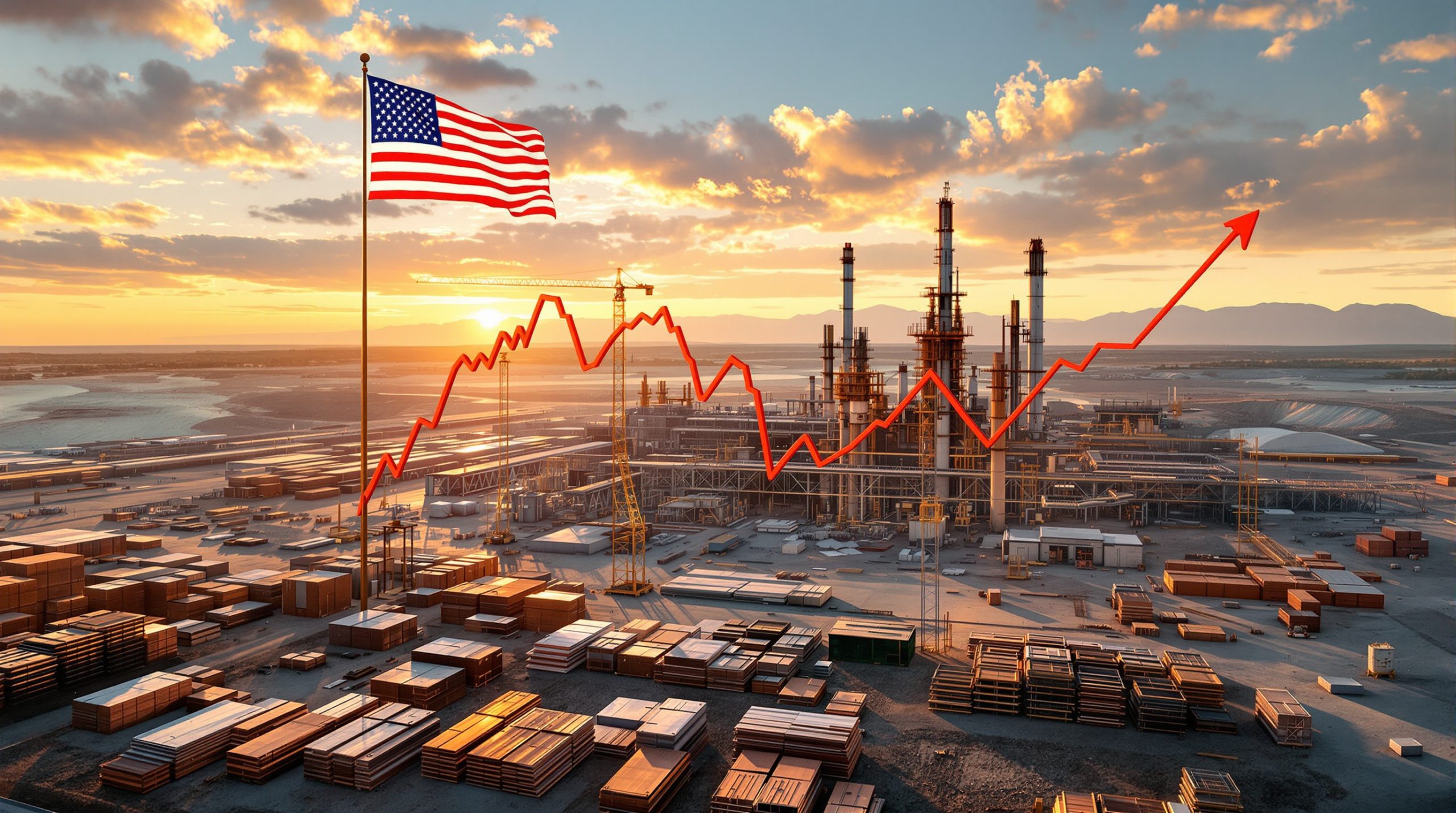How Are US Copper Tariffs Impacting the Global Supply Chain?
The clash between protectionist policies and processing constraints is reshaping copper markets and threatening the green energy transition.
What's Driving the US Copper Tariff Strategy?
The National Security Argument
The US administration has implemented copper tariffs based on a Section 232 investigation that concluded foreign copper dependence threatens national security. Despite holding 5.5% of global copper reserves (ranking sixth worldwide), the US remains heavily reliant on imports to satisfy demand from defense, energy, and technology sectors. In 2024, the country imported 810,000 tonnes of refined copper valued at approximately $10 billion—a 5% increase from the previous year.
The Tariff Implementation Timeline
The White House has introduced a two-pronged approach: immediate 50% tariffs on semi-finished copper products (including wires, rods, sheets, and manufacturing derivatives) effective August 2025, followed by a phased implementation for refined copper with 15% tariffs beginning in 2027 and increasing to 30% in 2028. This staggered approach caused market volatility, with copper futures experiencing their steepest one-day drop on record—plummeting from $5.63 to $4.35 per pound in late July after the announcement.
The Policy Paradox
Commerce Secretary Howard Lutnick has championed tariffs as essential for securing supply chains, but the policy creates a contradictory situation. The measures aim to "bring copper home," yet they primarily target downstream products rather than addressing the fundamental refining capacity shortage. This disconnect between policy goals and industry realities has undermined market confidence in the tariffs' effectiveness.
Why Can't the US Simply Increase Domestic Copper Production?
Current Production Outlook
The US copper sector is projected to grow at a 6.5% compound annual rate between 2024 and 2030, according to GlobalData. This expansion is supported by planned developments at Freeport-McMoRan's Bagdad and Lone Star mines in Arizona, which could contribute over 270,000 additional tonnes annually once operational in the late 2020s and early 2030s.
The Permitting Bottleneck
Despite holding approximately 55 million tonnes of copper reserves, restrictive permitting processes significantly impede development. The National Environmental Policy Act (NEPA) approval process can extend up to a decade, frequently delayed by appeals and litigation. The administration has expanded the FAST-41 regulatory streamlining program to address these delays, with ten copper projects now receiving "covered" status for expedited reviews.
The True Processing Challenge
Industry experts emphasize that increased mining output alone cannot resolve America's copper dependency. The critical bottleneck lies in refining capacity, not extraction. As Professor Ian Lange of the Colorado School of Mines notes: "The US will have to compete with Chinese smelters that are being built, which are going to have nearly zero cost of capital and some implicit government subsidy through sales to downstream manufacturers. If you are competing with them, well, good luck to you."
What's the State of Global Copper Refining Capacity?
China's Dominant Position
China maintains overwhelming control of global copper production, with state-backed smelters operating 97% of world capacity. Since 2019, Chinese companies have added approximately 11 million tonnes of refining capacity—representing 80% of all new global capacity additions. This concentration creates strategic vulnerabilities for countries dependent on refined copper imports.
America's Limited Infrastructure
The US refining landscape is sparse, consisting of just three significant facilities: Rio Tinto's Kennecott smelter in Utah, Freeport-McMoRan's Miami facility in Arizona, and the Asarco smelter, which has remained idle since 2019. This limited infrastructure cannot meet domestic demand, creating a widening supply gap that tariffs alone cannot address.
The Economics of Smelting
Building new refining capacity in the US faces significant economic headwinds. Chinese smelters benefit from low capital costs, government subsidies, and integration with downstream manufacturing. American facilities must contend with higher environmental standards, energy costs, and labor expenses, making it difficult to compete on a global scale without substantial government support beyond tariffs.
How Are Copper Markets Responding to the Tariff Announcement?
Price Volatility and Stockpiling
The market response to tariff announcements has been dramatic. As Jeffrey Lorch of McKinsey explained: "Because people expected tariffs, there was a lot of advanced purchasing of copper to try to build up a stockpile; they expected that this tariff would move to an import parity situation, which would allow a buck to be earned on this stockpile. What actually happened was that the tariff announced was underwhelming."
Supply Chain Adjustments
Manufacturers dependent on copper inputs are reassessing their supply chains and production strategies. The tariffs on semi-finished products are forcing companies to consider whether to import raw materials and process them domestically (despite limited capacity) or absorb higher costs for imported components. This reconfiguration is creating uncertainty throughout manufacturing sectors.
International Trade Dynamics
The US is reportedly negotiating with allies like the UK to establish alternative copper trade frameworks, seeking to secure supplies from trusted partners. Meanwhile, the global market is adjusting to potential shifts in trade flows as US importers seek ways to minimize tariff impacts while Chinese refiners potentially redirect output to other markets.
What Are the Implications for Green Energy Transition?
Critical Supply Chain Vulnerabilities
Copper is essential for renewable energy technologies, electric vehicles, and grid infrastructure. The energy transition is projected to drive a 50% increase in rising copper demand by 2035. Tariffs that increase costs without addressing refining capacity could impede deployment of these technologies and slow decarbonization efforts.
Competing Policy Objectives
The administration faces competing objectives: strengthening domestic supply chains while simultaneously accelerating clean energy deployment. Higher copper costs may undermine incentives created by the Inflation Reduction Act and other clean energy initiatives, creating policy friction between industrial and environmental goals.
Long-Term Investment Signals
The tariff structure sends mixed signals to potential investors in US copper refining. While it creates some incentive for domestic processing, the phased implementation for refined copper (beginning only in 2027) may not provide sufficient near-term motivation for the massive capital investments required to build new smelting capacity.
What Solutions Could Address the Refining Bottleneck?
Expanded Recycling Infrastructure
Copper recycling represents a significant opportunity to reduce import dependency. The US already generates substantial copper scrap but exports much of it due to limited domestic processing capacity. Investing in advanced recycling technologies could help close the refining gap while reducing environmental impacts associated with primary production.
Public-Private Partnerships
Addressing the refining bottleneck likely requires collaboration between government and industry. Strategic investments, loan guarantees, and long-term purchase agreements could help mitigate the financial risks associated with building new smelting capacity in a market dominated by lower-cost Chinese producers.
Targeted Regulatory Reforms
Beyond permitting streamlining, targeted regulatory approaches could help make domestic refining more competitive. This might include expedited environmental reviews for facilities incorporating best-available pollution control technologies, energy efficiency incentives, and workforce development programs to address labor constraints.
FAQ: Understanding the US Copper Supply Chain Challenge
How much copper does the US currently import?
In 2024, the US imported approximately 810,000 tonnes of refined copper valued at around $10 billion, representing a 5% increase from 2023 levels. This dependency has become a key strategic concern for policymakers focused on supply chain security.
Why doesn't the US process more of its own copper?
The primary constraints are insufficient refining capacity, high capital costs for new facilities, environmental regulations, and competition from heavily subsidized Chinese smelters. Additionally, lengthy permitting processes delay new projects, though recent reforms aim to streamline approvals.
Will tariffs succeed in reshoring copper production?
Industry experts express skepticism that tariffs alone can overcome the fundamental economic challenges facing US copper refining. Without addressing capital costs, environmental compliance expenses, and Chinese subsidies, tariffs may increase costs for manufacturers without significantly expanding domestic refining capacity.
How long would it take to build new US refining capacity?
Developing new copper smelting and refining facilities typically requires 5-7 years from planning through construction, assuming permitting proceeds smoothly. Given this timeline, even with policy support, meaningful expansion of US refining capacity would likely take until the early 2030s.
Conclusion: The Long Road to Copper Independence
Despite substantial reserves, tariff interventions, and permitting reforms, the United States faces a fundamental structural challenge in achieving copper supply chain independence. The refining bottleneck represents a critical vulnerability that cannot be quickly resolved through trade policy alone.
While domestic mining output is projected to grow significantly, bridging the refining gap will require sustained investment, regulatory innovation, and strategic partnerships. With Chinese smelters continuing to expand and global demand rising steadily, particularly from clean energy sectors, the US faces difficult choices about how to balance supply security, economic competitiveness, and environmental goals.
For now, Washington's ambition to "bring copper home" confronts the unyielding economics of global refining, raising questions about whether tariffs can deliver the self-sufficiency envisioned—or whether a more nuanced approach to supply chain resilience might better serve America's strategic interests.
Investors looking for opportunities amid this market disruption might consider various copper investment strategies to navigate the uncertainty. Furthermore, those interested in the future trajectory of copper markets should closely follow copper price prediction analyses from industry experts. Additionally, for those seeking geographical diversification, exploring copper-uranium investment options in resource-rich countries like Australia and Canada could provide portfolio protection against US market volatility.
| Key Metric | Current Status | Projected Trend |
|---|---|---|
| US Copper Reserves | 55 million tonnes (5.5% of global total) | Stable |
| US Mining Output | ~1.1 million tonnes annually | Growing at 6.5% CAGR through 2030 |
| US Refining Capacity | Limited to 3 major facilities | Minimal expansion expected short-term |
| Refined Copper Imports | 810,000 tonnes (2024) | Likely to remain high despite tariffs |
| Tariff Rate (Semi-finished) | 50% effective August 2025 | Stable through 2027 |
| Tariff Rate (Refined) | 0% currently | Rising to 15% (2027) and 30% (2028) |
Further Exploration:
Readers interested in learning more about global copper markets and supply chain dynamics can also explore related educational content available through Resources Review's coverage of mining and metals markets at Resources Review.
Are You Investing in ASX Resource Companies?
Stay ahead of the market with instant notifications on significant ASX mineral discoveries through Discovery Alert's proprietary Discovery IQ model, turning complex mineral data into actionable investment insights. Understand why major mineral discoveries can lead to significant market returns by exploring Discovery Alert's dedicated discoveries page, showcasing historic examples of exceptional outcomes.




